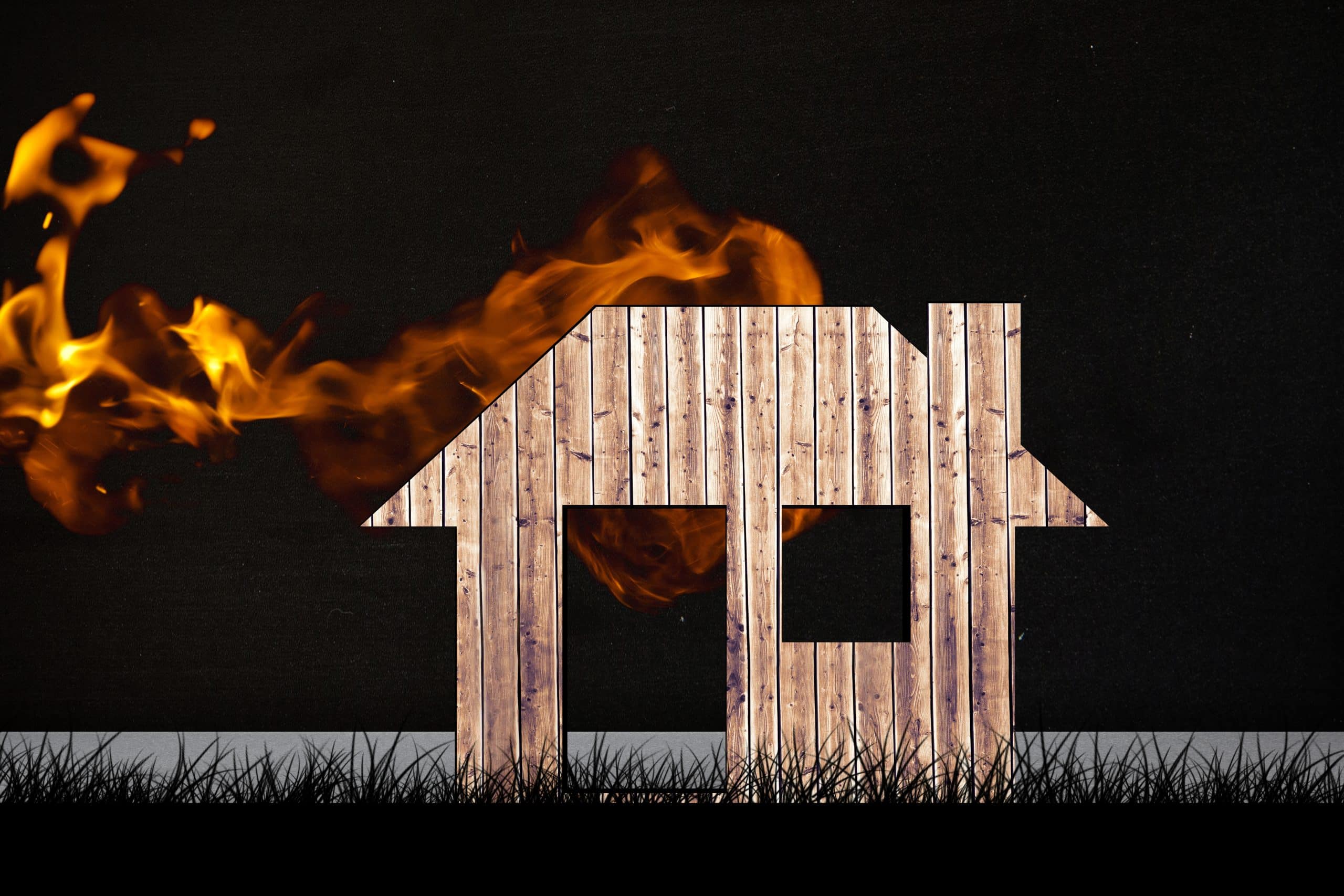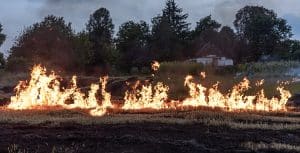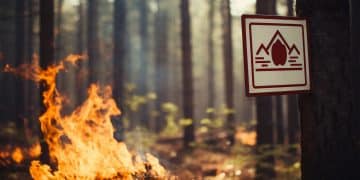NIFC daily large fires update: latest insights


The NIFC daily large fires update provides essential information on fire risks, statistics, and trends, helping communities and agencies prepare and respond effectively to wildfire threats.
Keeping up with the NIFC daily large fires update is essential for understanding fire risks and ensuring safety. These updates offer vital insights into current fire situations across different regions.
Ever wondered how these massive fires affect our environment and communities? Let’s dive in.
Current fire statistics and trends
Understanding current fire statistics and trends is crucial in managing and responding to large fires effectively. These stats not only show how frequent fires are but also where they are most likely to occur.
By analyzing these trends, fire management agencies can better allocate resources and warn communities.
Fire Statistics Overview
Every year, the number of large fires can vary widely. Recent reports show a significant increase in the frequency and scale of wildfires. This change poses a serious threat to both human safety and environmental health.
Knowing the statistics helps understand the increasing climate challenges we face.
- In 2022, over 50,000 wildfires were recorded across the United States.
- More than 7 million acres were burned by these fires, affecting wildlife and communities.
- Data shows a 30% rise in large fires compared to previous years.
Trends show that the summer months tend to see the highest number of active fires. This seasonal surge is often attributed to hotter temperatures and prolonged dry spells. Using these insights is vital for preparing and responding to fire risks.
Geographical Trends
Some areas are more prone to fires than others. States like California, Texas, and Oregon frequently report back-to-back fire seasons.
These regions often experience dry conditions and a buildup of flammable vegetation, making them particularly susceptible to wildfires.
Monitoring activities in these high-risk areas can alert firefighters and communities about potential threats. Meanwhile, early warning systems are essential in reducing damage and loss of life.
As we continue to face the realities of climate change, keeping a close watch on fire statistics and trends remains important. They highlight the urgent need for fire management practices and community preparedness efforts.
Key areas affected by large fires
Identifying the key areas affected by large fires helps us understand where to focus prevention and response efforts. Many regions face severe fire risks due to various factors such as climate, vegetation, and human activities.
These areas require immediate attention to mitigate damage and protect communities.
Regions at High Risk
Some states are consistently highlighted as high-risk zones for large fires. These areas often face hotter summers, less rainfall, and more dry vegetation, making them prime candidates for wildfires.
Following are some of the most severely affected areas:
- California: Known for its extensive forested areas and prolonged droughts, California suffers from significant wildfire outbreaks.
- Texas: With its mixture of grasslands and forests, Texas experiences substantial fire activity during dry periods.
- Oregon: The Pacific Northwest often sees large fires due to its mix of forests and summer heat.
- Arizona: This state faces wildfires due to dry conditions and high temperatures, especially in wooded areas.
Each of these states has unique environmental challenges that increase fire risks. Ongoing monitoring and data collection can help predict high-risk periods and improve safety measures.
The Impact on Communities
Large fires affect not only the environment but also local communities. Many families must evacuate their homes, and the fire can cause significant property damage.
Additionally, air quality degrades during fire events, leading to health issues for residents.
Understanding the key areas affected by large fires allows local governments and emergency responders to establish better warning systems and risk mitigation plans.
Community engagement and education play crucial roles in ensuring preparedness. With proper planning, communities can significantly reduce their vulnerability to these fierce blazes.
Preventive measures and safety tips

Taking preventive measures is essential for reducing the risk of large fires and ensuring safety in fire-prone areas. Knowing how to prepare can mean the difference between safety and disaster.
Here are important strategies to keep in mind.
Creating Defensible Space
One of the most effective ways to protect your home from wildfires is to create a defensible space around it. This involves clearing away flammable vegetation and debris.
Start by maintaining the area within at least 30 feet of your home:
- Remove dead plants, leaves, and other debris.
- Trim trees and shrubs to create a buffer zone.
- Use fire-resistant plants to replace flammable landscaping.
Creating this space increases your home’s chances during a wildfire and allows firefighters easier access for protection.
Emergency Preparedness
It’s essential to prepare for emergencies by developing an evacuation plan. Families should discuss how to exit safely during a fire. Everyone should know where to meet outside of the home.
Be ready for evacuation by having an emergency kit with essentials such as:
- Water and non-perishable food.
- Flashlights and batteries.
- First aid supplies.
Regularly check this kit to ensure everything is functional and stocked, allowing you to leave quickly with necessary items if needed.
Education and awareness are key to preventing fires. Participating in local fire safety programs can increase knowledge about risks and safe practices.
Always follow local guidelines regarding outdoor burning and fire restrictions, especially during dry seasons.
By staying informed and preparing effectively, communities can significantly reduce their fire risk. Implementing preventive measures and safety tips not only helps protect property but also saves lives.
Impacts on wildlife and ecosystem
The impacts on wildlife and ecosystem from large fires can be devastating and long-lasting. When flames sweep through forests and grasslands, they not only destroy vegetation but also disrupt the habitats of many animals.
Understanding these impacts helps us protect and recover ecosystems affected by wildfires.
Immediate Effects on Wildlife
Wildfires can lead to the immediate loss of animal life. Many species struggle to escape the flames and smoke. Additionally, their homes are destroyed, leaving them vulnerable.
Many animals, like deer and small mammals, may be forced to flee to unfamiliar territories.
- Habitat loss reduces food sources for many animals.
- Increased competition for resources can occur as animals relocate.
- Species that are already endangered may face even greater risks.
Survivors often experience great stress, leading to changes in behavior and reproduction patterns.
Long-term Ecosystem Changes
After a fire, the ecosystem undergoes significant changes. The loss of trees and plants means less shade and shelter, impacting soil health and local water cycles.
In time, this can result in soil erosion and loss of nutrients, further hindering recovery.
As ecosystems begin to recover, new plant species emerge, and some fire-adapted species thrive. This process can open the door for new animal species, creating a new balance in the ecosystem.
However, the speed of recovery depends on the severity of the fire and local conditions.
Finally, understanding the impacts on wildlife and ecosystem helps inform conservation efforts.
Post-fire recovery initiatives can support the reestablishment of habitats and contribute to biodiversity, ensuring that both wildlife and plants can thrive in the aftermath of a fire.
Future outlook for fire management

The future outlook for fire management is evolving as climate change and increasing wildfire incidents push for new strategies.
Fire management agencies are adapting to meet the challenges posed by larger and more frequent wildfires through innovative techniques and proactive measures.
New Technologies and Approaches
One significant change is the integration of technology into fire management. Drones and satellite imagery are being used to monitor fire behavior and assess terrain, enabling better planning and response.
These technologies provide real-time information, which is critical for effective decision-making.
- Remote sensing: Helps detect fires early, leading to quicker response times.
- Fire modeling software: Predicts fire spread and helps allocate resources efficiently.
- GIS mapping: Aids in visualizing areas at risk and planning evacuations.
Using data analytics and machine learning helps fire management agencies understand fire patterns and improve strategies. By analyzing historical data, they can anticipate future risks.
Community Engagement and Education
Engaging local communities is a crucial part of the future of fire management. Educating residents about fire safety and prevention creates a more prepared population.
Programs that encourage community participation in firebreak construction and ecosystem restoration can make a difference.
Public awareness campaigns can also raise understanding of fire risks. People need to know how to create defensible spaces and have emergency plans in place.
When communities work together with fire services, they enhance overall safety.
As the impacts of climate change continue to unfold, the future outlook for fire management focuses on resilience and adaptability.
Strategies that combine innovative technology with community involvement are keys to reducing wildfire risks and ensuring better preparedness in the years to come.
Conclusion
The fight against wildfires is no longer just a seasonal challenge but an ongoing reality that demands constant vigilance, innovation, and collaboration.
By following the NIFC daily large fires update, communities, agencies, and individuals gain access to critical data that enhances preparedness and response, ultimately saving lives and protecting ecosystems.
Yet, statistics and prevention are only part of the story. Each new blaze, such as the recent incidents in wilderness regions, reminds us of the urgent need for comprehensive strategies that blend technology, education, and community action.
The path forward requires resilience, building smarter defenses, fostering awareness, and investing in long-term sustainability.
For those seeking to stay fully informed, resources like the National Interagency Fire Center provide official nationwide updates, while local reports such as new fire alerts in Montana’s Lee Metcalf Wilderness highlight the very real, immediate threats communities face.
Together, these perspectives paint a vivid picture of the wildfire landscape and underscore the collective responsibility to act decisively in safeguarding our future.
FAQ – Frequently Asked Questions about Fire Management
What role does technology play in fire management?
Technology helps enhance fire monitoring and response through tools like drones and satellite imagery.
How can communities prepare for wildfires?
Communities can prepare by creating emergency plans, establishing defensible spaces, and participating in local fire safety programs.
What are the impacts of wildfires on wildlife?
Wildfires destroy habitats, affecting animal populations and leading to increased competition for resources among survivors.
What is the importance of community involvement in fire management?
Community involvement helps increase awareness, preparedness, and overall safety during fire incidents.
Liked the article?





